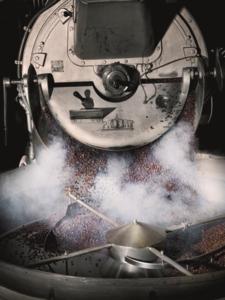Coffee roasting should master the yardstick
There are many drinks all over the world: tea, wine, leaf palmatine, cocoa, coffee, etc., but coffee has become the first drink, due to the reason: in the roasted coffee contains 700~800 kinds of substances related to flavor. Arabica beans contain more than 2000 ingredients, wine has more than 500 flavor-related substances, and vanilla has 150.

Definition of baking
Basically, coffee roasting is a pyrolysis that completely changes the substances inside the green beans, producing new compounds and recombining them to form aromas and alcohol flavors. This effect only occurs at high temperatures, and if only low temperatures are used, decomposition cannot be caused, no matter how long the coffee beans are roasted.
In this process, coffee will undergo considerable changes, mainly in the following aspects:
★ Weight loss: After roasting, the water evaporates and the moisture content of the coffee beans drops from 13% to 1%. Moreover, the silver skin falls off and some substances volatilize at high temperatures, so coffee beans will lose weight by 12% to 21%. The deeper the roasting, the greater the weight loss.
Volume expansion: At the end of this process, the volume of coffee beans will increase by 60%.
★ Cell pore enlargement: The cell wall of raw beans is hard and the cell pores are closed, so it is not easy to deteriorate. But after baking, the cell walls become fragile, and the larger the pores, the easier it is to lose material.
★ Carbon dioxide formation: Carbohydrates inside coffee beans decompose during high temperature decomposition, and combine with other substances to form a large amount of carbon dioxide, which resides inside coffee beans.
Changes in organization and structure: Roasting changes the internal organization of coffee. Carbohydrates decreased from 58.9% to 38.3%.
Important Notice :
前街咖啡 FrontStreet Coffee has moved to new addredd:
FrontStreet Coffee Address: 315,Donghua East Road,GuangZhou
Tel:020 38364473
- Prev

Points for attention in Coffee planting
When the fruit of the coffee tree is picked, the four layers of skin wrapped around the coffee beans need to be removed in order to finally get the coffee beans needed. The main methods to remove the outer epidermis of coffee beans are "wet treatment" and "dry treatment".
- Next

The two most important coffee varieties in the world
Arabica coffee beans Arabica coffee tree plant morphology is relatively slender shrubs, leaves are oval, green, natural growth height generally up to 5-6 meters, artificial planting needs to control its height at about 3 meters, in order to facilitate future picking. Arabica coffee trees generally have a life span of 20-30 years.
Related
- Guji coffee producing area of Guji, Ethiopia: Humbela, Shakiso, Wulaga
- What is the most expensive variety of Qiloso in BOP multi-variety group?
- How to store the coffee beans bought home?
- Why are Yemeni coffee beans so rare now?
- Ethiopian Sidamo all Red Fruit Sun Sun Santa Vini Coffee beans
- SOE is mostly sour? What does it mean? Is it a single bean? what's the difference between it and Italian blending?
- Is Italian coffee beans suitable for making hand-brewed coffee?
- How to choose coffee beans when making cold coffee? What kind of coffee beans are suitable for making cold coffee?
- Just entered the pit to make coffee, what kind of coffee beans should be chosen?
- Can only Japan buy real Blue Mountain Coffee? What are authentic Jamaican Blue Mountain coffee beans?

